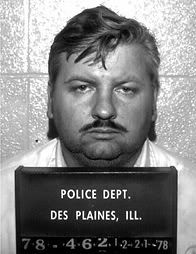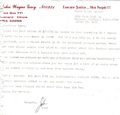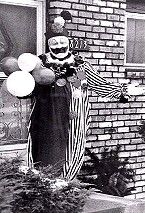Wayne Allen Sallee: Plague of the Killer Clown
By, Martel Sardina
Wayne Allen Sallee is without question one of the most fascinating people you will ever meet. How many people have been hit by both a car and a bus and lived to tell about it? How many have persevered against a debilitating medical condition and still managed to publish fiction for more than twenty years? The fact that Wayne is still here despite all of the lumps life has thrown in his path never ceases to amaze.
In Wayne’s writing life, he is a five-time finalist for the coveted Bram Stoker Award. While he would like his fans to remember him for his body of work, including The Holy Terror (a novel) and more short stories than you can shake a stick at, the thing most people want to talk to him about is his correspondence with notorious serial killer, John Wayne Gacy. We at Dark Scribe Magazine are no exception.
Dark Scribe Magazine: For those who don’t know, John Wayne Gacy was convicted and executed for the rapes and subsequent murders of thirty-three male victims in the 1970's. How  did you wind up corresponding with one of the most notorious serial killers of our time?
did you wind up corresponding with one of the most notorious serial killers of our time?
Wayne Allen Sallee: I was at a convention out at Stony Brook University [on Long Island, New York]. Someone had brought a copy of an article that had just been published called “They Call Him Mr. Gacy.” It was simply letters that were sent to him and copies of the letters that he sent back. It was very prolific. There was even a letter from Oprah Winfrey requesting a televised interview. I was interested in writing to Gacy for research, to see what the prison system would allow him to receive and what I would receive back. The letters in the article gave his lockbox number in Menard Correctional Center. I wrote to him in 1991. I really didn’t know what to ask him about other than his artwork because that’s what everybody would talk about, that he had artwork for sale. Because of the “Son of Sam” law, convicts can’t profit from their crimes, so he had some guy in Indiana selling the artwork on his behalf.
Dark Scribe: Did you ever consider purchasing his artwork?
Wayne Allen Sallee: I scanned over the price list, and I honestly thought about spending the sixty-five dollars and buying his picture of Elvis. But I couldn’t do it. It sickened me to think about it. The only thing I wanted from Gacy were letters that I could put in my research file in case I needed information about the process of corresponding with an inmate or to know what the letterhead looked like for the purpose of writing fiction. I really assumed that I’d be getting letters that were blacked out, or a form letter.

Sallee received this typewritten letter from convicted killer Gacy in March of 1991.
Dark Scribe: Did you get personalized letters? Or were they form letters?
Wayne Allen Sallee: The responses were mixed. I did get a form letter when I asked him about mass murderer Richard Speck. I had been doing research for a book about Richard Speck. At one point during the research, I learned that Speck did a lot of paintings but they were paint-by-number. I wanted to find out what Gacy thought about Speck, who died of a heart attack in 1991. The letter I got back in response was a form letter stating that I couldn’t ask certain questions of inmates.
Dark Scribe: You couldn’t ask about what Gacy’s relationship was to other inmates?
Wayne Allen Sallee: Right.
Dark Scribe: Did you find it interesting that he asked you to fill out a questionnaire before he would respond to your questions? That he only give information quid-pro-quo? He wanted to know something about you before telling you anything about himself.
Wayne Allen Sallee: Just like Hannibal Lecter (laughs). “Quid-pro-quo, Clarice.”  I believe I made up most of my replies. I wrote my name and address but everything else, I felt he doesn’t need to know anything. If I wrote hobbies – ballet dancing, fine. At the time, he still insisted that he would reply with his letter that he still wanted a photo [of me].
I believe I made up most of my replies. I wrote my name and address but everything else, I felt he doesn’t need to know anything. If I wrote hobbies – ballet dancing, fine. At the time, he still insisted that he would reply with his letter that he still wanted a photo [of me].
Dark Scribe: Didn’t Gacy collect trinkets from the different people that he killed?
Wayne Allen Sallee: He did and that’s what was odd because he was fairly calculated in everything he did. He probably would have kept on killing for years if they hadn’t caught him. The last person he kidnapped, Robert Piest, had a film developing receipt that had fallen out of his pocket and was lying in Gacy’s car. Even though they had questioned Gacy in the past, mostly from him hanging out in Washington Square Park, that receipt was the link the cops needed to prove Gacy was involved.
Dark Scribe: It makes you wonder why he’d want to keep evidence, except that having that tangible reminder of the crime is a way to relive it.
Wayne Allen Sallee: That’s why I didn’t want to send them a photo of me. So I went down near the Colony Theater, near 59th and Kedzie. About a block away there’s a bar called Clown’s Alley. I took a photo of the exterior and mailed it to him. I said, “I honestly don’t have any photos of me to send you, but I thought you’d like this since you like clowns.” He got the name “Pogo” because he was Polish and he was always on the go. That’s why he called himself “Pogo the Clown.” And so then, he sent the letter back, which was only the questionnaire. It’s pretty creepy just reading through that. That’s what I’m saddened most about: while writing “The Last Days,” they didn’t have room to put the questionnaire in there, and also I believe the editor was afraid of being sued if he included it with the article.

Gacy completed this questionnaire for Sallee, only after Sallee completed one of his own for Gacy.
Dark Scribe: I found it interesting that Gacy tried to get the people who wrote to him on his level by asking questions like “What is the worst thing you’ve ever done?” We’ve all done bad things, things we don’t want to admit. How does that make us different? That’s kind of creepy. That, in his mind, he would try to twist peoples’ perceptions of what he did in order to make himself look less guilty or not guilty.
Wayne Allen Sallee: I tried to reply in a good enough way that he wouldn’t say, “oh this is crap.” But on that question, I think my answer was something like, I called in sick to work but I wasn’t really sick. I kept it, not idiotic but gave him enough to be believable. So he’d assume I was being truthful in my answers. But I think the one thing that got me with him was his reply where it said the address Death Row, Menard, IL. That’s all it said. That was kind of eerie. The end of the road, you’re not going any further and to know that you’re going to die.
Dark Scribe: In your correspondence, where you able to determine if Gacy had contact with the other inmates or was he segregated?
Wayne Allen Sallee: No, he wasn’t segregated at all. He kept to himself though. Between his painting and his writing, he just spent many days writing. He asked people to send him stamps and paper to write on. There were five or six letters in all. All of the letters were typed on a manual typewriter.

Part two of Gacy's questionnaire responses, completed quid pro-quo in a style reminiscent of the fictional Hannibal Lecter.
Dark Scribe: There’s a tendency to believe that horror writers are fascinated with serial killers and write about them because they want to know them on a personal level. I want to make it clear to our readers that you were not a “fan” of John Wayne Gacy. For authors who write fiction based on true crime, like Jack Ketchum and yourself, it’s more about getting into that person’s mind and creating your “monster” for whatever story you’re working. It is not fan worship of the serial killer but abhorrent disgust. Was the point of your research to understand what Gacy thought about the crimes and how he justified his actions?
Wayne Allen Sallee: I couldn’t even ask him questions about the crimes. I kept it as vague as possible. He would ask for photos. He collected photos of the people he corresponded with. He’d rather have a face to go with the letter. And I didn’t want to do that. I didn’t want any part of him in my life past this research, just a tactile reference point to someone like that.
He would send out a flyer with each letter, unless you were asking about the artwork. And, each one quoted Robert Ressler, who coined the phrase “serial killer” back in the late ‘70’s, about how the cops flubbed something with the evidence, so Gacy always had that in big, bold print and would constantly refer to himself, in the correspondence itself, as a different persona that he called “The Media Monster” or “The Monster The Media Created.” He never once talked about being the killer. He talked about the fact that he became a monster only after the news people and the cops got involved. That was as close as he ever came to talking about the crimes.
Dark Scribe: Did it seem to you that he felt wrongly accused? That he was being persecuted?
Wayne Allen Sallee: He always felt that way. He never once spoke about what he did. He did not claim innocence, but simply stated there’s a media monster and there’s him. He did what he did in real life. The area around Clark Street in the ‘70’s and ‘80’s was very much a gay area. Gacy would go there and pretend to be a cop named Jack Hanley that was his alias. So again, it’s like with the media monster thing, he would always project something else. But then he’d end up picking up these gay men and then say, “Well, I won’t arrest you but we’re going to go back to my place.” Then he’d do the handcuff trick or the rope trick or whatever. I always thought that he always kept projecting himself as something other than John Gacy.
Dark Scribe: By doing that, he never had to taken responsibility for his actions.

Sallee received this letter from Gacy in April of 1994.
Wayne Allen Sallee: Right. The very last letter that I received just had a Post-It note on there. By the time I knew that I was going to be writing the article for Death Realm about Gacy’s last days, it became a matter of constantly writing him so that I could get as much information, to get a sense of the passage of time. Not to get one letter in 1991 and one in 1994, but to try and get letters every six months, and even if he was just repeating himself, that in itself says something. I’d written to him several times trying to push buttons, do whatever I could. People who knew I was writing the article would send me things. Ann Kennedy was doing a magazine called The Silver Web, and she sent me an interview with Gacy from The New Yorker, and I mentioned it in one of the letters. Gacy pretty much ranted about that, all the untruths and everything. That’s a letter that I was happy for. He hand wrote it and it said, “I’ve been very busy lately with the lawyers. The interview in The New Yorker is complete b.s. I didn’t say any of the things the author attributed to me. Later, J.W.” The Post-It was stuck on yet another piece of paper, not the old photo of him with the grungy look and the moustache, but the newer one where he almost does look like Brian Dennehy, who played him in To Catch A Killer. That was postmarked on the Thursday before his execution. I got that letter on Tuesday after his execution.
Dark Scribe: How did you wind up witnessing the execution?
Wayne Allen Sallee: I called Nic Howell, the spokesman for the Illinois Department of Corrections, and I told him what I wanted to do. He told me to fax over my resume. He gave me the go ahead to go down there, not to be an actual witness to the execution but they had a separate room. It was a u-shaped room, not counting the hallway. They had Gacy in another room and wheeled him in and down to the bottom part of the u and then up the next leg to the room where [the execution] was done, which was the room where the witnesses would watch also. I was able to see him as passed by.
Dark Scribe: The room you were in was the press room?
Wayne Allen Sallee: Yes, but you weren’t allowed to take photos or anything like that. People could write about his state of mind, what he looked like, whether he looked peaceful or angry.
Dark Scribe: How weird was it being a part of that?
Wayne Allen Sallee: It was strange because it was the first time I’d seen him in person. It made me think about all sorts of things. With Gacy, I’ve always remembered different things, different aspects about him and about the time that the bodies were discovered. I was taking classes to be a 1980 census taker. I remembered things like that, that I’d leave these classes, go home and watch the news about these bodies being taken out. I remembered when they tore down his house. I was just reminded of those things as they wheeled him through. He didn’t look at anybody. He was just kind of staring up at the ceiling. I’m fairly certain that he didn’t have much to say in regards to confession. It did take a while for him to die. They screwed up on one of the injections. There are three different injections given. They screwed up on one of them, so it actually took around twenty minutes for him to die; usually it’s around seven minutes or so.
Dark Scribe: What happened next? Did someone come out to tell you that he was dead?
Wayne Allen Sallee: Nic Howell, the IDOC spokesman, came out and made a formal announcement. John Wayne Gacy, was pronounced dead at 1:07 a.m. on Tuesday May 9th. Here in Illinois, most of the executions occur at midnight even though there haven’t been that many.
Dark Scribe: What do you remember about the aftermath of Gacy’s execution?

Sallee was prohibited from asking Gacy certain questions about other inmates, and certain items were returned to him by the prison.
Wayne Allen Sallee: After the execution, [Chicago radio personalities] Don Wade and Roma threw a Gacy’s Day Parade in the Loop. I went there on my lunch hour. There was a clown walking around with a suitcase with writing on the side that said, “Clowns make people laugh. They don’t just kill people.” I took his photo and kept trying to talk to him, but he kept his head down, never acknowledged me. He kept walking around the crowd with his suitcase and never once said a word. People were carrying placards that said “Stick it to Gacy,” and idiotic things like “Burn, Gacy, Burn” which makes no sense if you know what’s done, unless they meant symbolically like “burn in Hell.” Or “Fry Gacy.” They laid out sheets, one for each of his victims, and that was it. I went to that. I was happy too, because I got the photo of the clown.
Dark Scribe: What do you think would have happened if had he not been executed? You know when Governor Ryan commuted all the death-row sentences? What do you think would’ve happened in that case?
Wayne Allen Sallee: If he wasn’t dead by now, Gacy would be like William Heirens, who killed Susan Degnan back in 1946. He’s been denied parole close to fifty times now. He’s around eighty. Gacy would be like him, still writing letters, still doing what he always did, denying everything, and you know I think that always insane. People are so bold when they go out and kill people and think they’re going to get away with it, and very few of them even admit to it once they are in prison. With Ted Bundy, he finally started admitting other murders only because it bought him more time in not being executed.
It would have been interesting to see if Gacy, if it hadn’t exploded all at once, but ended up where there was enough of a pattern, if the police would’ve ended up giving him some code name or if the press would have. But back then, it was 1979, nobody really knew about serial killers. There was the Zodiac in San Francisco and that was really about it. Everybody else they called mass-murderers or spree-killers, like Charles Starkweather. One of the guys I always thought would be cool to correspond with, but they won’t let people write to him, is Howard Unruh. He’s in prison in New Jersey but back in 1949, he just kind of went crazy. He lived in Camden, New Jersey, and he got annoyed because when he would leave his apartment, he lived in an L-shaped apartment in the back, and the woman who lived in the front complained because he would shut the metal gate very loudly. So at one point he snapped and walked around with a gun and randomly killed seven or eight people, wounded quite a few others. He went into a barber shop and killed a little boy getting his hair cut. He shot the woman who always yelled at him about the gate. Someone like that would be interesting to hear from, too. I think right now, that’s the only other person that I’d even care to know in the same manner that I knew Gacy.
Dark Scribe: Is that because you are trying to understand why he did what he did?
Wayne Allen Sallee: Well, that and to see what they would allow me to send him. With Gacy, I really believed that I would get a letter back from him where whole lines would be blackened out by the warden. Presumably I could have even called the prison and found out what the procedure was or whatever. I was naïve in assuming that Gacy would write back huge paragraphs and that they’d blacken out parts. But all of his letters were fairly short. I assume that’s how he managed to do so much correspondence. All the letters were short.
Dark Scribe: Do you have any parting thoughts on Gacy?
Wayne Allen Sallee: I’m glad he’s dead. Why do serial killers always wind up being called by their full names? Everyone knew him as John Gacy - not John Wayne Gacy.
Dark Scribe: I think they do it just to give you a hard time.
Wayne Allen Sallee is currently working on his second novel, City With No Second Chances. Midnight Library will reissue his first novel, The Holy Terror, later this year. Wayne’s short story collection, Fiends By Torchlight, is currently available for sale from Annihilation Press and was recently reviewed by DSM (see our 'Reviews' page).
All Photos Courtesy of Wayne Allen Sallee / Used with Permission




Reader Comments